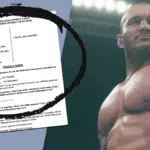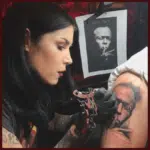In a decision with frightening implications, a court in Illinois holds that a jury will decide whether Randy Orton’s tattoo artist can control the use of the wrestler’s image in video games.
Ok, picture this: You decide to get a tattoo. You know it’s going to be permanent, so you do your homework and take all reasonable precautions. You find an experienced, qualified artist. You find a shop that’s clean and safe. You double and triple check the design to make sure it looks exactly the way you want it and doesn’t have any misspelled words. After all, you don’t want to have any ragrets down the line.
What you probably don’t do, however, is have any sort of discussion with the tattoo artist about copyrights and permissions. You certainly don’t bring along an assignment or license agreement for the tattoo artist to sign. Why would you? After all, it’s your tattoo and your body, right?
Right?
Maybe not. What would you say if I told you that twelve strangers would be given the power to determine whether you could legally control the use of your tattooed likeness in photographs, commercials, motion pictures and video games? What if you were an actor, model, musician or anyone else whose livelihood depended on your appearance in expressive or commercial works? What if I told you that you might need permission from your tattoo artist to do those things?
Don’t shoot the messenger, but that’s basically what a federal judge in Illinois has found, ruling that a jury will get to decide whether or not a video game publisher’s realistic depiction of professional wrestler Randy Orton in the “WWE 2K” video game series infringes tattoo artist Catherine Alexander’s copyrights in Orton’s tattoos.
Alexander v. Take-Two Interactive
Here’s a quick rundown of the facts: Alexander inked six tattoos on Orton between 2002 and 2008. They included tribal designs, a Bible verse, a dove, a rose and a skull. Alexander and Orton never discussed anything about copyrights or permissions when Orton got the tattoos, or at any time afterwards.




Orton went on to become a famous wrestler with WWE. He’s held the WWE Championship nine times and WWE’s World Heavyweight Championship four times. Some consider him one of the greatest professional wrestlers ever. Meanwhile, Catherine Alexander has not worked as a tattoo artist since 2009 and has never licensed the use of any of her tattoos in other media.
As part of his wrestling deal, Orton licensed the right to use his name and likeness to WWE. WWE then sublicensed those name and likeness rights, along with those of other wrestlers, to Take-Two Interactive, publisher of the popular “WWE 2K” video games. Orton’s likeness—including his tattoos—was featured in “WWE 2K16,” “WWE 2K17,” and “WWE 2K18.”

Nobody associated with the game got Alexander’s permission to include Randy Orton’s tattoos in WWE 2K. Upset, Alexander hired a lawyer, who in 2018 applied to register six copyrights in Orton’s tattoos and then filed a copyright infringement lawsuit against Take-Two, WWE and others involved with the games.
Solid Oak Sketches v. 2K Games
If this whole scenario sounds vaguely familiar to you, it may be because Take-Two was a defendant in a nearly identical lawsuit decided in its favor earlier this year, Solid Oak Sketches v. 2K Games. That case involved the alleged infringement of tattoos on LeBron James, Kenyon Martin and other basketball players whose likenesses were featured in Take-Two’s NBA 2K video games. Judge Swain in the Southern District of New York granted Take-Two’s summary judgment motion and dismissed the case based on three grounds:
- First, the court held that Take-Two’s use of the tattoos in the NBA 2K games was de minimis. As I’ve previously discussed, this means that any copying was so trivial that it couldn’t support a claim for infringement. The tattoos weren’t an integral part of the game as a whole, appearing for only brief moments during game play and accounting for only a miniscule portion of game data.
- Second, the court held that the tattoo artists who inked the basketball players appearing in the games necessarily granted the players nonexclusive implied licenses to use the tattoos as part of their likenesses.
- Third, the court found that the defendants’ reproduction of the tattoos in NBA 2K was a fair use. While the original purpose of the tattoos was as body art, Take Two’s purpose was to accurately and realistically depict the players in its games. The tattoos were also merely incidental to the commercial value of the games.
Take-Two’s Summary Judgment Motion in Alexander
Having won the NBA 2K case, you’d forgive Take-Two’s lawyers for thinking their chances on summary judgment in the WWE 2K dispute were pretty pretty good. But the court in the Alexander case rejected every one of Take Two’s arguments, and did so without so much as mentioning the Solid Oaks Sketches case in its opinion.
Frankly, it’s hard to overstate how misguided the court’s decision in Alexander really is. After the opinion came out last week, I actually waited to write about the case, thinking that the court might reconsider the opinion on its own. That didn’t happen, so here we are. Let’s talk about what the court found, but more importantly, the implications of the decision.
De Minimis Use
On the issue of whether the use of Orton’s tattoo’s in WWE 2K was de minimis, Take-Two made the same argument it had successfully advanced in Solid Oak Sketches: Randy Orton is one of many wrestlers in the WWE 2K games, it’s difficult to see his tattoos during the game, and the tattoos comprise a small percentage of the game data. On this point, the court questioned whether the Seventh Circuit even recognized the de minimis doctrine, noting that neither party had cited any cases for the proposition. But as my colleague Dan Nabel has pointed out, the Seventh Circuit has, in fact, upheld the principle of de minimis copying in a case that Take-Two did, in fact, cite. The Alexander court also found that the de minimis standard was not met because Take-Two used the “entirety” of the plaintiffs’ works. That’s really beside the point if the use is wholly insignificant or fleeting, a point that the court ignored.
Fair Use
On fair use, the court found a triable issue of fact for a jury to decide, noting that Alexander contended that she created the tattoos for the purpose of displaying them on Orton’s body, and that Take-Two used them for the same purpose; to display them on Orton’s body in its video games. The court paid no attention whatsoever to the transformative nature of the WWE 2K games themselves, or the fact that the argument, taken to its logical conclusion, would effectively prevent realistic representations of a tattooed individual in expressive works. The court didn’t even attempt to determine whether there was any market harm, other than reciting each of the parties’ arguments and passing responsibility to a jury to sort it all out.
Implied License
The court’s treatment of implied license is where it really failed to take the real world implications of Alexander’s copyright lawsuit into account. The court cited Alexander’s assertion that she would “take issue” if any client were to replicate her tattoo works to print and sell commercial items. And yet Alexander admits she never disclosed this to any of her clients. These customers would no doubt be shocked to learn that by getting a tattoo that day, Alexander would be able to effectively control their ability to use or profit from their own likenesses.
The parties, not surprisingly, never discussed that by getting a tattoo, Orton would be restricted in any way from licensing the use of his image and likeness. But instead of treating Alexander’s failure to convey or discuss any restrictions to Orton as a basis for implying a lack of restrictions, the court suggested that it negated a license. Of course, the failure to expressly discuss conditions on use is precisely why any license must be implied, an issue that the jury now has to decide as well.
Practical Implications of the Court’s Decision
By refusing to dismiss the Alexander case and instead sending it to the jury to decide, the court has effectively ruled that anyone with a tattoo is not in control of the uses to which his or her likeness is put. Under the decision, unless you expressly negotiate the terms of a license with your tattoo artist up front, there’s nothing to stop the artist from objecting later to a license she doesn’t approve.
And this doesn’t only extend to the use of one’s likeness in commercial advertisements or products. After all, the U.S. Supreme Court has already declared video games to be “expressive works” entitled to the same First Amendment protection afforded to motion pictures and literature. If the court’s ruling were to stand, it could effectively prevent anyone with a tattoo from appearing on film or even in a photo posted on social media without a jury weighing in on fair use. That should be a troubling thought, whether or not you have a tattoo.
Do I think a jury will understand what’s at stake here? I think so. I certainly hope so. But as the gatekeeper of the court, the trial judge should have never put us in a position of having to find out.
Let me know what you think about the case. Comment below, and follow me on Twitter for more.







2 comments
Randy Orton debuted on WWE tv in March of 2002. So the entire timeframe for his getting those tattoos was during his time being heavily featured on a weekly television program. On top of that, his tattoos have been included in every video game he’s been featured in. That goes all the way back to 2003.
I honestly don’t see how the judge could let this go to trial. If the tattoo artist didn’t know that Orton was in the public eye/in video games when she first tattooed him, she definitely knew by the time she did the last one in ‘08. Yet she said nothing for a decade. A decade in which at least ten video games were released that featured those tattoos.
I hope the jury does the right thing here. Even as someone without tattoos and not in the public eye, I find it to be a scary prospect with a lot of dangerous implications if they don’t.
The implications aren’t as dire as you’re making them out to be.
Its pretty unique situation as far as Randy Orton is concerned, due to him wrestling under his birth name (and only because his family name is famous ) but artist isn’t claiming ownership over Orton the *person*’s ink. She’s claiming ownership over the tattoos on Randy Orton, the character who WWE owns. And its pretty impossible to claim that the tattoos aren’t part of his character
The Ultimate Warrior sued (and won) over the right to use his likeness in a comic book he co-authored, so there’s some precedent there